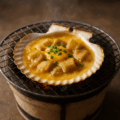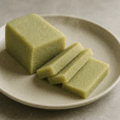鱈のじゃっぱ汁の特徴
“じゃっぱ”=頭や骨まで使い切る冬の知恵
「じゃっぱ」とは方言で“アラ(頭・骨・皮・内臓など)”のこと。寒鱈の旨みを余すことなく味噌仕立ての汁に炊き込み、体の芯から温まる青森の冬の定番です。
骨と皮のだし、白子や肝でコク足し
骨や皮からコラーゲンとだしが出て、滋味深い味わいに。仕上げに白子や肝を加えると、まろやかさとコクが増します。
根菜・豆腐・ねぎで食べ応え
大根や人参、豆腐、ねぎを合わせ、味噌の香りでまとめます。生姜を少量きかせると後味すっきり。
鱈のじゃっぱ汁のレシピ
材料(4人分)
- 鱈のアラ(頭・骨・皮などぶつ切り) … 600〜800g
- 鱈の切り身 … 200g(お好みで)
- 鱈の白子 … 150〜200g(お好みで)
- 鱈の肝 … 50〜80g(お好みで)
- 大根 … 200g(5〜7mm厚いちょう切り)
- 長ねぎ … 1本(斜め切り/仕上げ用に小口も少々)
- 木綿豆腐 … 1/2丁(1.5cm角)
だし・調味
- 水 … 1,200ml
- 昆布 … 5×10cm 1枚
- 酒 … 大さじ3
- 米味噌 … 大さじ4〜5(好みで調整)
- 醤油 … 小さじ1/2(味の輪郭を整える用・任意)
- 塩 … 少々(仕上げの調整)
作り方
- 下処理:鱈のアラは熱湯を回しかけてすぐ冷水に取り(霜降り)、血やぬめりを洗い落とす。白子は塩少々と酒少々をふって10分おき、さっと洗って水気を拭く。肝は薄い血管を除き、塩水で軽くすすぐ。
- だしを引く:鍋に水・昆布・酒・鱈のアラを入れて中弱火。沸騰直前に昆布を外し、アクを取りながら10〜15分静かに煮て旨みを出す。
- 具を煮る:大根を加え、中火で8〜10分。豆腐・長ねぎ(斜め切り)・生姜を入れる。
- 味噌を溶く:火を弱め、味噌の半量を溶き入れて3分ほど煮る。
- 仕上げ:白子・肝・鱈の切り身を入れ、沸騰させずに1〜2分、白子がふるんと固まる程度にやさしく火入れ。残りの味噌で味を決め、足りなければ醤油・塩で微調整。小口のねぎを散らす。
シェフのワンポイントアドバイス
臭み抜きは霜降り+アク取りが基本。味噌は二段投入で香りを残し、白子投入後は決してぐらぐら煮立てない(80〜90℃目安)。
白子の火加減が難しいと思った場合には別の鍋で茹でるのも良いでしょう。
七味や柚子こしょうなどとよく合い、1日寝かせるとさらに味がなじみます。
栄養価(1杯の目安)
- エネルギー:約220〜330 kcal(白子・肝の有無で変動)
- たんぱく質:20〜30 g
- 脂質:10〜18 g
- 炭水化物:8〜15 g
- ビタミンB群・D、セレン(鱈由来)/ヨウ素(昆布)
高たんぱくで比較的低脂質。味噌量で塩分をコントロールしやすい一杯です。
歴史
寒鱈を丸ごと味わう港町の鍋
厳冬期に豊漁となる鱈の“じゃっぱ”(アラ)を活かした漁師料理として広まり、家庭でも正月〜冬のごちそうとして親しまれてきました。
地域ごとの味の違い
基本は味噌仕立てだが、醤油で軽く仕立てる家も。白子や肝を入れる・入れない、ねぎや生姜の利かせ方など、家庭ごとの個性が光ります。
English Version
Features of Cod “Jappa-jiru”
“Jappa” = Winter wisdom to use head, bones, and trimmings
In local dialect, “jappa” means the fish trimmings—head, bones, skin, innards. Aomori’s winter staple simmers cold-season cod in a miso-based soup so none of its flavor is wasted, warming you to the core.
Broth from bones and skin; richness from milt and liver
Bones and skin release collagen and deep savor. Finishing with cod milt (shirako) and liver adds gentle creaminess and body.
Hearty with roots, tofu, and scallions
Daikon, tofu, and negi round it out, unified by fragrant miso. A touch of ginger keeps the aftertaste clean.
Recipe
Ingredients (serves 4)
- Cod trimmings (head, bones, skin; cut up) … 600–800 g
- Cod fillet … 200 g (optional)
- Cod milt (shirako) … 150–200 g (optional)
- Cod liver … 50–80 g (optional)
- Daikon … 200 g (5–7 mm half-moons)
- Long green onion (negi) … 1 stalk (on a bias; plus some thinly sliced for garnish)
- Firm tofu … 1/2 block (1.5 cm cubes)
Broth & Seasoning
- Water … 1,200 ml
- Kombu … 1 sheet (5 × 10 cm)
- Sake … 3 tbsp
- Rice miso … 4–5 tbsp (to taste)
- Soy sauce … 1/2 tsp (optional; sharpens the finish)
- Salt … a pinch (final adjustment)
Instructions
- Prep: Scald the cod trimmings with boiling water and immediately chill (shimo-furi), then rinse off blood and slime. For milt, sprinkle a little salt and sake, rest 10 minutes, rinse, and pat dry. Trim veins from the liver and rinse lightly in salted water.
- Draw the broth: In a pot, combine water, kombu, sake, and cod trimmings. Heat gently; remove kombu just before boiling. Skim foam and extract quietly 10–15 minutes.
- Simmer the solids: Add daikon and cook over medium heat 8–10 minutes. Add tofu and the sliced negi.
- Add miso: Lower the heat and dissolve in half the miso; simmer about 3 minutes.
- Finish: Add shirako, liver, and cod fillet. Do not boil; warm gently 1–2 minutes until the milt just firms with a delicate wobble. Season with the remaining miso; fine-tune with soy sauce or salt. Garnish with thinly sliced negi.
Chef’s Tip
Odor control = shimo-furi + diligent skimming. Use a two-stage miso add to preserve aroma, and after adding milt keep the temperature below a simmer (about 80–90°C). If handling milt is tricky, poach it separately and add at the end. Shichimi or yuzu-kosho pair well, and resting the soup overnight deepens the flavor.
Nutritional Value (per bowl, approx.)
- Calories: 220–330 kcal (varies with milt/liver)
- Protein: 20–30 g
- Fat: 10–18 g
- Carbohydrates: 8–15 g
- B vitamins & vitamin D, selenium (from cod) / Iodine (from kombu)
High protein and relatively low fat. Salt is easy to control by adjusting miso.
History
A harbor-town hotpot that uses winter cod nose-to-tail
Born as a fishermen’s dish making full use of abundant midwinter cod “jappa,” it became a home favorite for New Year through the cold season.
Regional personality
Miso is standard, but some families prefer a lighter soy-based broth. Whether to include milt or liver, and how assertive the ginger and negi are—these choices showcase each household’s style.



何でも質問してください!